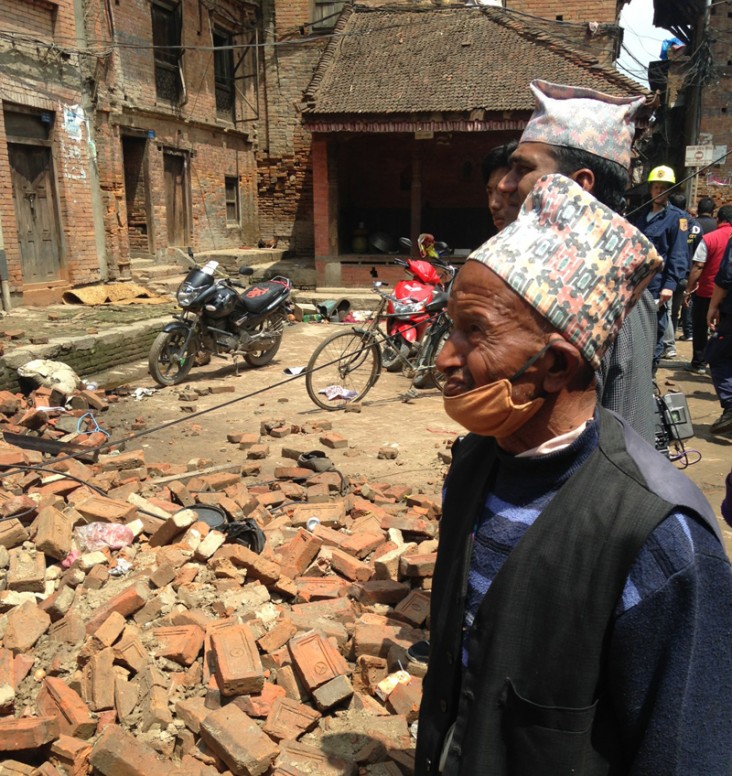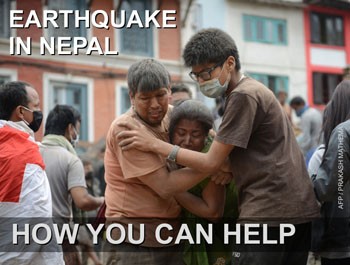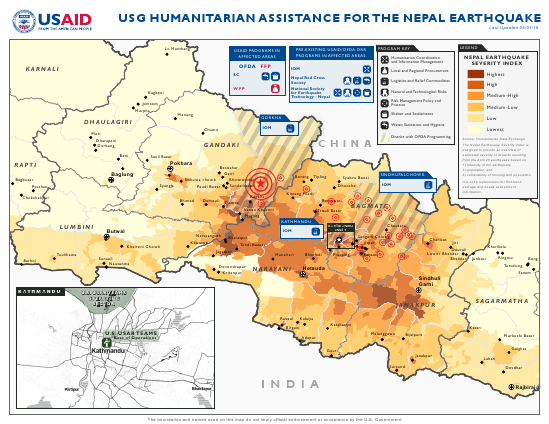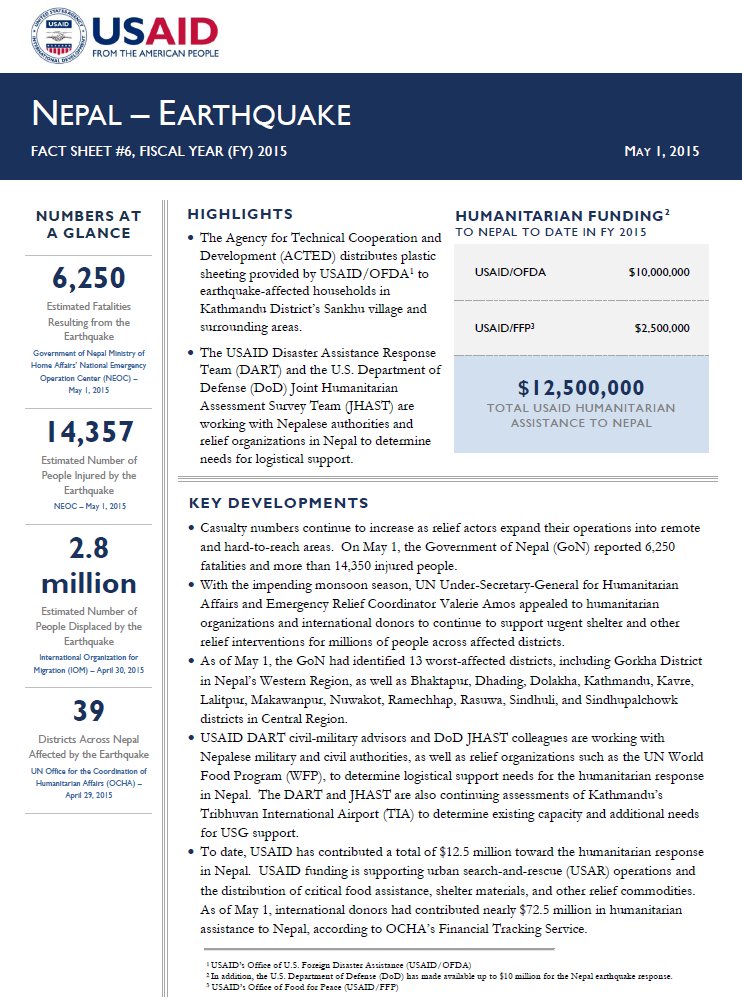May 1, 2015
Highlights
The Agency for Technical Cooperation and Development (ACTED) distributes plastic sheeting provided by USAID/OFDA to earthquake-affected households in Kathmandu District’s Sankhu village and surrounding areas.
The USAID Disaster Assistance Response Team (DART) and the U.S. Department of Defense (DoD) Joint Humanitarian Assessment Survey Team (JHAST) are working with Nepalese authorities and relief organizations in Nepal to determine needs for logistical support.
Key Developments
Casualty numbers continue to increase as relief actors expand their operations into remote and hard-to-reach areas. On May 1, the Government of Nepal (GoN) reported 6,250 fatalities and more than 14,350 injured people.
Nepal Earthquake Map - May 1, 2015 ![]() (pdf - 2 MB)
(pdf - 2 MB)
Numbers At A Glance
6,250
14,357
2.8 million
39
Humanitarian Funding:
To Nepal To Date In FY2015:
| USAID/OFDA | $10,000,000 |
| USAID/FFP | $2,500,000 |
| TOTAL | $12,500,000 |
In addition, the U.S. Department of Defense (DoD) has made available up to $10 million for the Nepal earthquake response.
Nepal Earthquake Fact Sheet #6 - 05-01-2015 ![]() (pdf - 194k)
(pdf - 194k)
With the impending monsoon season, UN Under-Secretary-General for Humanitarian Affairs and Emergency Relief Coordinator Valerie Amos appealed to humanitarian organizations and international donors to continue to support urgent shelter and other relief interventions for millions of people across affected districts.
As of May 1, the GoN had identified 13 worst-affected districts, including Gorkha District in Nepal’s Western Region, as well as Bhaktapur, Dhading, Dolakha, Kathmandu, Kavre, Lalitpur, Makawanpur, Nuwakot, Ramechhap, Rasuwa, Sindhuli, and Sindhupalchowk districts in Central Region.
USAID DART civil-military advisors and DoD JHAST colleagues are working with Nepalese military and civil authorities, as well as relief organizations such as the UN World Food Program (WFP), to determine logistical support needs for the humanitarian response in Nepal. The DART and JHAST are also continuing assessments of Kathmandu’s Tribhuvan International Airport (TIA) to determine existing capacity and additional needs for USG support.
To date, USAID has contributed a total of $12.5 million toward the humanitarian response in Nepal. USAID funding is supporting urban search-and-rescue (USAR) operations and the distribution of critical food assistance, shelter materials, and other relief commodities. As of May 1, international donors had contributed nearly $72.5 million in humanitarian assistance to Nepal, according to OCHA’s Financial Tracking Service.
USAR AND LOGISTICS
As of April 30, the USAID USAR teams had completed all GoN-assigned search-and-rescue missions in Kathmandu. On May 1, the GoN requested that the two U.S. teams conduct rescue efforts in severely affected Rasuwa District, a mountainous region located north of Kathmandu. However, road blockages hindered access and prevented execution of the mission.
According to medical staff at Israel’s field hospital, the 15-year-old boy rescued on April 30 by the USAID USAR teams in coordination with the GoN is recovering well and is expected to be discharged in the coming days.
To date, international USAR teams have conducted 15 live rescues, including three in the past 24 hours, and treated more than 1,100 injured people. USAR teams have also recovered approximately 135 dead bodies from collapsed structures. In the coming days, priorities are expected to shift from search-and-rescue efforts to dead body management, the identification of missing people, family reunifications, and other relief activities.
Limited road access in rural areas beyond Kathmandu continues to hinder humanitarian aid delivery, according to relief actors. To support rescue and relief efforts in hard-to-reach areas, UN Disaster Assessment and Coordination (UNDAC) teams have established humanitarian hubs in Dhading and Gorkha districts.
According to the Logistics Cluster—the coordinating body for humanitarian logistical activities, comprising UN agencies, non-governmental organizations (NGOs) , and other stakeholders—four mobile storage units (MSUs) are presently available in the humanitarian staging area at TIA in Kathmandu. Since the response began, the staging area has received emergency relief commodities from governments and humanitarian organizations, including health, shelter, and water, sanitation, and hygiene (WASH) supplies. Due to continued congestion at TIA, the Logistics Cluster is facilitating transportation of humanitarian cargo from the airport to the humanitarian staging area.
SHELTER
Current estimates indicate that the April 25 earthquake destroyed 160,786 houses and damaged an additional 143,357 residences, according to the NEOC. With the impending monsoon season, shelter support remains the most urgent need in affected communities, the UN reports.
To date, humanitarian organizations have provided approximately 30,000 tarps, as well as blankets, solar lamps, and other supplies, to households in need. Plans to distribute another 80,000 tarps are underway.
On May 1, ACTED distributed 200 rolls of USAID/OFDA heavy-duty plastic sheeting from the supply of 700 rolls consigned to IOM the previous day. The distribution is providing critical shelter support to earthquake-affected households in Kathmandu District’s Sankhu village and surrounding areas. IOM has dispatched the remaining 500 rolls to Save the Children (SC), which plans to distribute the plastic sheeting to households in Gorkha, Kathmandu, and Sindhupalchowk.
DISPLACEMENT

As of April 30, nearly 24,000 internally displaced persons (IDPs) continued to shelter in 13 GoN-identified open spaces—comprising public parks, recreational fields, schools, and other designated sites—in Bhaktapur, Kathmandu, and Lalitpur districts, according to IOM’s displacement tracking matrix. Based on preliminary assessments, IOM estimates that site populations range from 500 to 4,000 IDPs.
While a number of actors, including the GoN, the private sector, and NGOs, have provided basic services to camp populations, service provision across the camps is uneven, IOM reports. Identified priorities include food assistance, shelter support, and WASH services. Although camp populations continue to decrease as IDPs return to their homes in Kathmandu or to their hometowns in rural areas beyond the city, structural vulnerability assessments of damaged houses are needed to determine if it is safe for residual populations to return to their homes, IOM reports.
HEALTH
In recent days, the GoN Ministry of Health and the UN World Health Organization (WHO) conducted assessments of 21 hospitals in 10 districts, including six facilities in Kathmandu Valley. According to WHO, 17 of the hospitals are functional but require essential medications, medical equipment, and materials. All of the functional hospitals reported sufficient staffing. Twenty of the 21 hospitals reported a decrease in the number of trauma patients since the peak on April 25–26. The four non-functional hospitals visited were either severely damaged or completely destroyed by the earthquake and are located in Nuwakot, Ramechhap, Rasuwa, and Sindhupalchowk districts. Timely assessments of health facilities in other affected areas are critical, and WHO plans to increase coordination with health partners to complete them.
The GoN and UN officials have deployed 40 foreign medical teams to various locations in Nepal. Médecins Sans Frontières (MSF) is currently flying to remote areas, such as Langtang and Rasuwa, to conduct assessments and establish mobile medical clinics as needed. In many remote areas, residents lack basic services, and roads and trails are blocked, according to MSF. While populations in these areas did not exhibit serious medical problems, most urgently require food and shelter assistance. MSF reported that the medical situation is stable but underscored that health issues may develop if food, shelter, and WASH needs remain unmet.
WASH
The WASH Cluster in Nepal—led by the GoN’s Ministry of Urban Development, with the UN Children’s Fund (UNICEF) serving as the co-lead—is in the initial stages of development and coordination. The cluster has begun mapping WASH partner locations, with one cluster partner serving as the overall lead in each district.
Water supply in most areas of displacement is adequate, according to WASH actors. Although many formal displacement sites also have latrines, most toilets are filled and, consequently, unusable. Some of the informal displacement sites in Kathmandu Valley—the ones not established by the GoN—have received less emergency assistance, resulting in more urgent WASH needs, according to cluster partners. Greater relief focus is also needed in rural areas. In Gorkha District, CARE is actively distributing hygiene kits; and in Sindhupalchowk District, the UN Human Settlements Program (UN-HABITAT) is providing water treatment tablets and hygiene kits, including by air transport to reach more remote areas.
To date, WASH Cluster partners have provided more than 100,000 people with potable water and approximately 77,000 people across seven severely affected districts with hygiene promotion services. In addition, cluster partners have distributed more than 200 water storage tanks to address the needs of displaced populations in the formal IDP sites in Kathmandu Valley.
FOOD SECURITY
The UN Food and Agriculture Organization (FAO) anticipates a significant impact on food security and agriculture-based livelihoods due to disruptions to the planting season, as well as the likely loss of livestock, food supplies, and agricultural inputs following the earthquake. With the rice-sowing season beginning in late May, farmers are in urgent need of key agricultural inputs and support; those who miss this critical window will be unable to harvest rice until late 2016, the FAO reports.
Initial assessments conducted by the UN World Food Program (WFP) indicate significant disruptions to markets in 10 affected districts. Of 91 markets assessed, 50 percent were reported as non-operative due to damaged or destroyed infrastructure, insufficient food stocks, and displaced shopkeepers. Humanitarian organizations anticipate that market disruptions will further heighten the earthquake’s impact on livelihoods and food security.
According to the Food Security Cluster, up to 3.5 million people in affected communities may require livelihood recovery assistance, while 1.4 million people require urgent food assistance. To date, USAID’s Office of Food for Peace (USAID/FFP) has provided WFP with $2.5 million for the purchase of 1,390 metric tons (MT) of rice to address the critical food needs of approximately 120,000 earthquake-affected people for one month.
CONTEXT
On April 25, a magnitude 7.8 earthquake struck central Nepal at a shallow depth of approximately 15 kilometers (km), according to the USGS. The epicenter of the earthquake was located approximately 77 km northwest of Kathmandu, the country’s capital city, and 73 km east of Pokhara, another major city in central Nepal.
The USG immediately issued a disaster declaration for Nepal due to the effects of the earthquake. Within hours of the seismic event, USAID/OFDA had activated a RMT in Washington, D.C., and deployed a DART—including USAR specialists—to support emergency response efforts in Nepal.
For nearly two decades, USAID/OFDA has supported disaster risk reduction (DRR) efforts in Nepal, including throughout Kathmandu Valley. USAID/OFDA funding has enabled the International Organization for Migration (IOM) to identify, prepare, and preserve more than 80 open spaces in Kathmandu Valley to ensure the sites are available for humanitarian purposes—such as distribution centers or warehouses—in the event of large-scale disasters. USAID/OFDA has also supported NRCS to pre-position critical emergency relief supplies in order to address the immediate needs of affected communities following a disaster.
Through the Kathmandu-based National Society for Earthquake Technology (NSET), USAID/OFDA is strengthening Nepal’s earthquake response capacity by institutionalizing DRR at the local and national levels in collaboration with the GoN, non-governmental organizations, schools, and local communities. With USAID/OFDA support, NSET is also promoting public-private partnerships for earthquake risk management and enhancing the capacity of municipal governments to develop and administer building code permits and control systems to better protect against seismic activity.
PUBLIC DONATION INFORMATION
The most effective way people can assist relief efforts is by making cash contributions to humanitarian organizations that are conducting relief operations. A list of humanitarian organizations that are accepting cash donations for disaster responses around the world can be found at www.interaction.org.
USAID encourages cash donations because they allow aid professionals to procure the exact items needed (often in the affected region); reduce the burden on scarce resources (such as transportation routes, staff time, and warehouse space); can be transferred very quickly and without transportation costs; support the economy of the disaster-stricken region; and ensure culturally, dietary, and environmentally appropriate assistance.
More information can be found at:
- The Center for International Disaster Information: www.cidi.org or +1.202.821.1999.
-
Information on relief activities of the humanitarian community can be found at www.reliefweb.int.










Comment
Make a general inquiry or suggest an improvement.